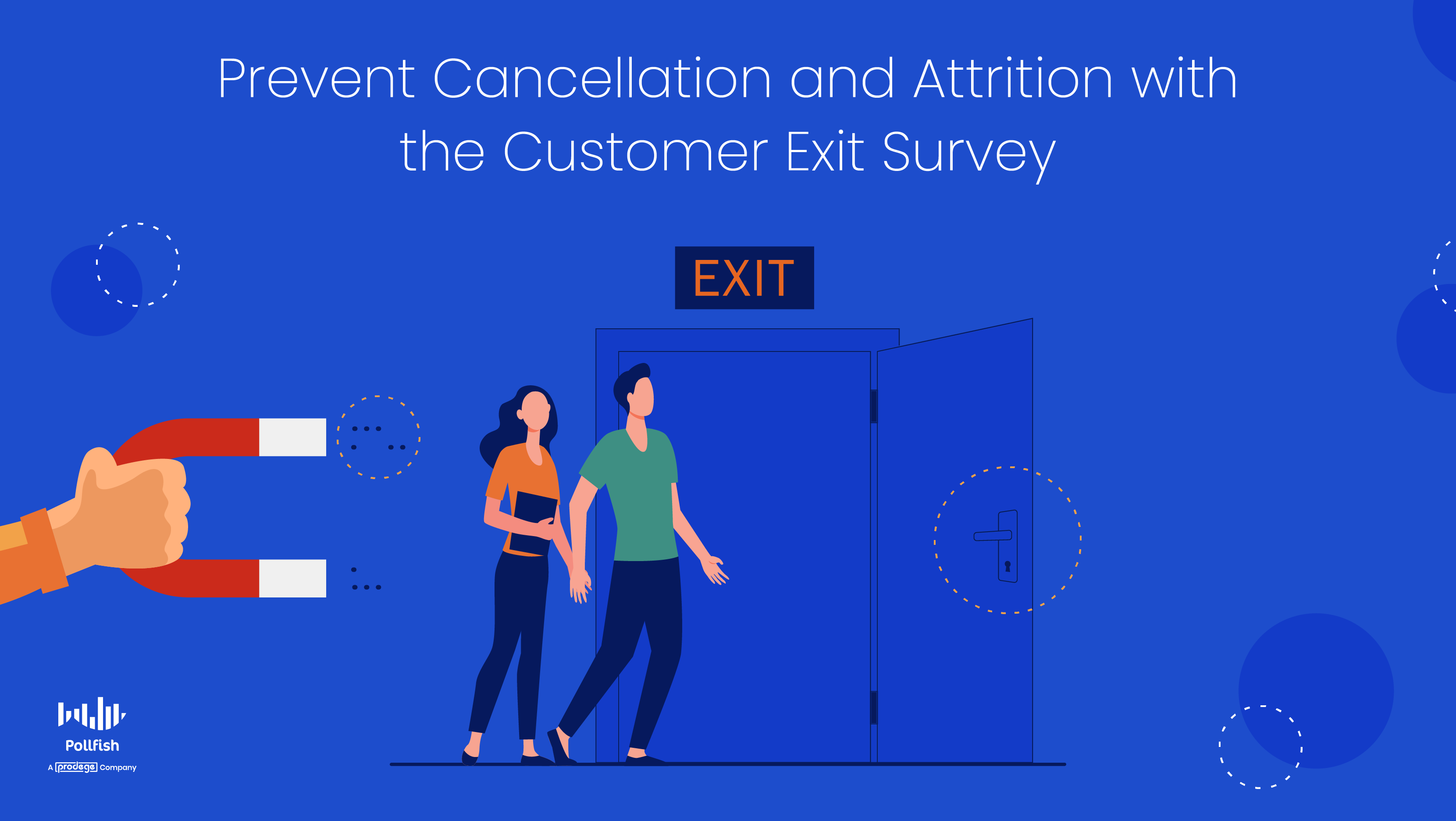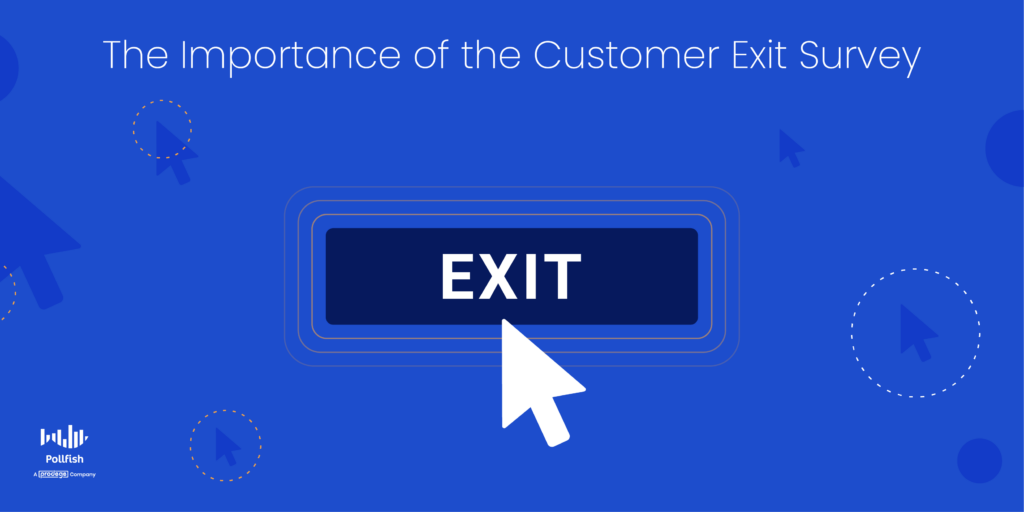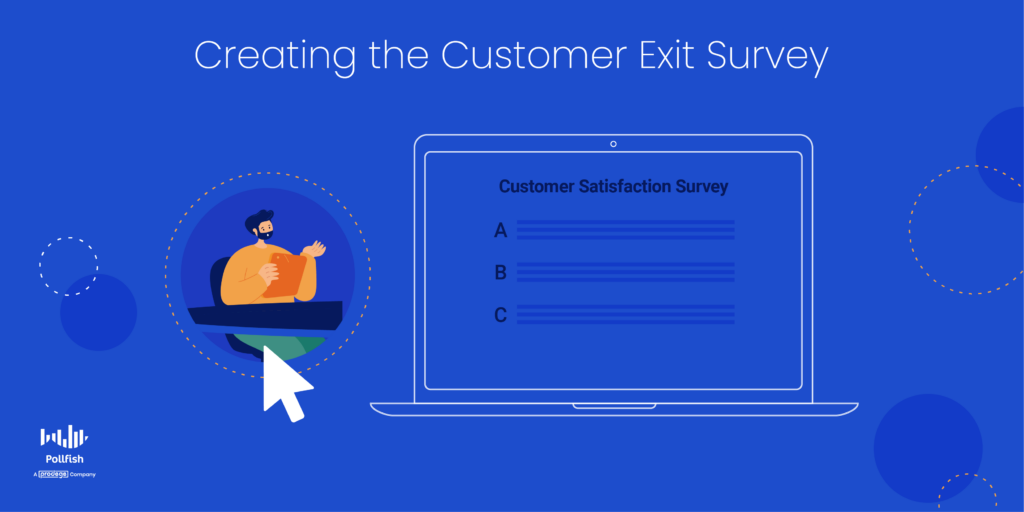Preventing Cancellation and Attrition with the Customer Exit Survey

The customer exit survey is a convenient tool to use to prevent customers from canceling their subscriptions and other forms of customer attrition. All businesses experience churn and in many cases, it is preventable.
In order to evade customer attrition, you need to tackle its core cause and this survey allows you to dig its root cause up. This way, you’ll understand exactly how your consumers feel so that you can avoid dissatisfying them and optimize your brand experience.
No matter how well a business has mastered consumer loyalty, it is bound to lose some customers. The average American company loses 23% to 30% of its customers each year.
What’s more is that the loss of customers has been on the rise. Since 2016, customer retention loss has risen by 37% due to poor customer service. There are a variety of other factors that cause customers to churn — a lack of consumer loyalty sums them up, as no customer would make repeat purchases with brands they don’t trust.
This article delves into the customer exit survey, its importance, when to implement it, how to create it and more, so that you can avoid cancellations and keep more of your customers.
Understanding the Customer Exit Survey
A customer exit survey is a kind of consumer survey used to study customers who are about to cancel their subscription or already have. Although it is particularly relevant to the SaaS sector, given the prevalence of subscription-based SaaS products, it is also useful for a variety of other types of businesses.
This survey is especially applicable to other forms of subscription services, such as content subscriptions — this includes print and online magazines, newspapers, newsletters, trade magazines, etc.
In addition, you can also deploy it in non-subscription settings, given the weight of the customer attrition rate. However, in these instances, you’ll need to have conducted prior market research to glean an awareness of customers who are dissatisfied to the point of leaving your brand, switching brands or beginning an order cancellation.
There are more instances where applying this kind of survey is relevant and useful. These include the following scenarios:
- During periods of high bounce rates across different site pages
- When users begin an order and cancel it
- When users begin an order but don’t complete it
- When users start a sign-up process for notifications or newsletters but don’t complete it
- In instances where paying customers churn
- During times where customers sign up for a product but don’t use it
The customer exit survey helps reveal all kinds of sentiment surrounding your product and the experience associated with it. After all, there are various stages and components of the customer buying journey that can contribute to customers seeking to exit or already having exited.
The Importance of the Customer Exit Survey
There are so many survey types you can conduct to improve your customer experience. The customer exit survey is important to carry out for a number of reasons.

First off, this kind of survey is product-oriented. It helps you obtain crucial information about how well your products meet the needs and requirements of your customers. In regards to the product specifically, this survey extracts key information such as the following:
- Product-market fit
- You can determine if you are targeting the right audience.
- You can also tighten your product-market fit.
- Features
- It allows you to learn if your product truly provides the tools your customers need and want.
- In this way, you’ll have key information on how to innovate your product.
- Bugs
- You can discover if there are bugs that you may not have been aware of.
- It works as a user research method, capturing insights on design flaws that impact usability.
This survey is more than merely an offshoot of a product satisfaction survey. This is because you can set it up to garner various other insights that you can use to reduce customer churn.
This includes asking about the customer support your customers receive, allowing you to see if you’re lacking on this front, along with how to improve it, so that customers can use your product with ease and trust your support team.
Additionally, it allows you to gauge your customer convenience — or lack thereof. As its name implies, this concept refers to simplifying all customer touchpoints, as well as making them friction-free.
Furthermore, helps you understand how your CX compares with that of your competitors, facilitating part of your competitive analysis.
By studying your consumers in regards to all that pertains to their canceling a subscription or ending their patronage in other ways, you’ll be able to amend all of your points of friction and other mistakes.
In doing so, this survey helps improve customer satisfaction in various aspects of your customer experience, thereby preventing future cancellations. As such, it helps lower customer churn rate, allowing you to retain more of your customers, which hold colossal importance.
After all, it is much more cost-effective and profitable to retain existing customers than to acquire new ones. There are many reasons that support this, such as the fact that gaining a new customer can cost five times more than retaining one. Additionally, increasing customer retention by just 5% can increase profits from 25-95%, to name a few.
Given that this survey allows you to improve your products, support, CX and more, you’ll be stunting attrition and increasing your customer retention rate. As such, the customer exit survey grants invaluable insights into how well your product suits the goals and needs of your target market, shielding your brand against future cancellations.
When to Deploy the Customer Exit Survey
There are various situations where this survey is especially useful. Many of these are explained in the second section of this article. To understand when to deploy this survey comprehensibly, it is crucial to understand which specific parts of the customer journey are most apt for using this survey.
The following lists examples of the best time to send a survey in order to ward off customer exits and improve your customer experience:
- If you received a low score on a Net Promoter Score survey.
- This indicates your customers are unhappy with your subscription/product, as they wouldn’t recommend you to friends or colleagues.
- A score of 0-6 represents detractors, which you should immediately survey.
- A score of 7-8 represents passive, who may not want to cancel, but are not very satisfied with your offerings, thus, they can be made into detractors.
- If you received a low score on the Customer Effort Score, or CES survey.
- This shows the amount of effort that a customer puts into a certain interaction with your company.
- This is usually expressed on a scale of either “very difficult” to “very easy.
- There are two approaches to this scaling system.
- Upon discovery of high bounce rates across different site pages.
- If you notice a high bounce rate on a certain landing page or blog post, you ought to survey customers on what made them bounce.
- When users cancel an order.
- Survey them as soon as possible.
- Ask questions about the checkout to see if it had any effect on their cancellation.
- Ask directly what made them cancel their order.
- When users are in the midst of an order but don’t complete it after an hour.
- The page may have become stagnant from disuse.
- In this case, they may have found a better offer online.
- As such, ask them if they’ve found another product or about what they would change about yours.
- When paying customers barely spend time on a SaaS product.
- This includes little time spent on a product, or high bounces on one.
- This also involves weeks where users go days without using the product.
- When users start a sign-up process but don’t complete it.
- Make sure to inquire if they are still interested.
- Ask about what made them change their minds — if they have.
- When customers return a product they haven’t used.
- Ask for the reason behind their return.
- Was the product a gift? Do they want to save money?
- This can signify the customer not knowing about the full extent of the benefits of the product.
- In all instances where paying customers churn.
- Consider asking why they won’t renew a subscription.
- Consider offering promotions and discounts to retain them.
- Upon receiving any negative customer feedback.
- Whether your customers complained via a voice of the customer (VOC) program, over the phone or in person, consider that the beginning of their dissatisfaction, the kind that may lead to churn.
- Follow up with a customer exit survey in order to retain the customers.
- Ask if their complaint has any effect on their subscription or opinions of products.
How to Create the Customer Exit Survey
There are multiple approaches to take when creating this survey, as the above sections explain that there is not solely one or two instances in which to apply this survey. There are several stages in the customer journey where it is apt to use this survey, including pre and post-exit and even before they’ve purchased.
The latter refers to the nurturing stages, where users are in the mid-stages of the sales funnel. These instances often involve customers bouncing — another form of customer attrition — along with others.

The following lays out the steps on how to create a customer exit survey:
- Apply consumer analysis on all areas where customers churn or are near churning.
- This involves consulting your website analytics and the host of your website marketplace.
- This also pertains to keeping track of in-store and online returns and complaints therein.
- Pay special attention to cancellations, a lack of renewals, little time spent using a product, returns and bounce rates.
- Use the results of previously conducted survey campaigns to discover whether your customers are dissatisfied with your brand.
- Refer to the aforementioned NPS and CES surveys.
- Conduct new surveys on customer satisfaction to catch the presence of unhappy customers or those who feel your brand is mediocre.
- Use the customer satisfaction survey to gauge levels of satisfaction.
- Use the customer experience survey to understand various moments in the CX.
- Use the customer retention survey to discover how to retain your customers.
- Analyze and consolidate the findings from your survey research and the presence of customer dissatisfaction and churn in your CX (from Step 1).
- Jot down all your findings and compare them across channels, purchase methods and the place of churn.
- Divide your findings into three sections:
- The most outstanding places of churn, including cancellations, discontinuation of renewal and returns.
- Churn on content and digital assets only.
- Considerations of churn (evidenced by poor survey scores, complaints, bad reviews, etc.)
- After dividing your findings into three sections, create survey campaigns centered on the topics in each section.
- This will organize your survey so that you don’t jam all topics into one, which will be irrelevant to all your customers, given they belong to a specific kind of section and therefore a specific customer exit.
- Begin your survey by targeting the correct respondents.
- Send your surveys via email or on a webpage.
- Also, consider setting up an automatic survey to signed-in users who bounce.
- Use a viable online survey platform, one that allows you to send surveys to specific individuals.
- Begin with a set of preliminary questions.
- Consider using a mix of open-ended and close-ended questions.
- You can use open-ended questions as follow-ups to close-ended questions, or as standalone questions.
- Optimize your survey for desktop and mobile.
- Your online survey platform should offer a mobile-first design, since mobile dominates the digital space.
- Consider adding A/B testing to test different versions of a product or subscription, along with those currently under development.
- Use multimedia elements to keep respondents engaged and see the product visually.
- Thank your customers for taking your survey.
- Analyze your findings and make necessary changes.
- Now that you have gathered data on customer exits, you should use all of it to analyze things such as:
- What irks your customers the most.
- What your customers wish your subscription, platform or product offered.
- What in the CX triggered customer dissatisfaction and exits.
- Make all the necessary changes.
- You’ll need to convene with your product designers, marketers, customer success and support teams to inform them of the necessary changes.
- You ought to share survey results to forge data democratization, which smooths the process of keeping everyone in the know and involved.
- Now that you have gathered data on customer exits, you should use all of it to analyze things such as:
- Tell your customers about the new changes you’ve made.
- This will show them you took their feedback into consideration and acted upon it.
- It will also directly prove that you’ve improved your product, support and other aspects of their CX.
- As such, it may revert them from canceling their subscriptions or make them renew.
- Additionally, it may attract them to buy from your business once again.
Keeping All Your Customers
The customer exit survey provides key insights that help you prevalent product and subscription cancellations, along with other kinds of customer attrition. In order to carry one out, you’ll need a quality online survey platform.
As such, you should use an online survey platform that makes it easy to create and deploy all kinds of surveys. It should offer random device engagement (RDE) sampling to reach customers in their natural digital environments, as opposed to pre-recruiting them.
Your online survey platform should also offer artificial intelligence and machine learning to remove low-quality data, disqualify low-quality data and offer a broad range of survey and question types.
The survey platform should offer advanced skip logic to route respondents to relevant follow-up questions based on their previous answers. It should also make it easy to form a customer journey survey to survey your respondents across their customer journeys.
Additionally, it should also allow you to survey anyone. As such, you’ll need a platform with a reach to millions of consumers, along with one that offers the Distribution Link feature. This feature will allow you to send your survey to specific customers, instead of only deploying them across a vast network.
With an online survey platform with all of these capabilities, you’ll be able to gain useful insights and avoid customer exits at all costs.
Pollfish Marketing Team
Ready to Try Pollfish?
Create your survey with AI, target high-quality respondents starting at $0.95 per complete, and start getting results in just minutes in real-time. From running a simple product concept survey to managing a constant stream of trackers for dozens of clients in dozens of countries, we’ve got you.
